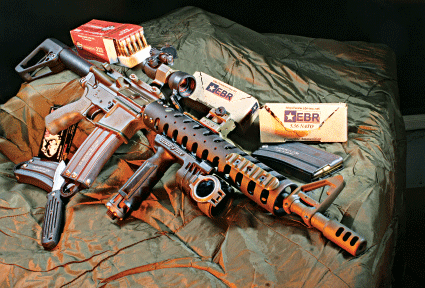Dave Lauck has been in the custom firearms business for some 30 years, carrying on the family tradition of firearms manufacturing since the days of Colonial America. Lauck’s goal is to provide his customers with the finest, most reliable, accurate, practical, and tactical firearms available using traditional craftsmanship coupled with state-of-the-art innovations. We have already evaluated several of Lauck’s custom firearms and when Dave contacted us about testing his D&L Sports CQB AR carbine, we jumped at the opportunity.
Based on previous experience, we believe that D&L Sports produces some of the finest AR-type rifles available. We have seen a lot of these rifles in the last 40 or so years, beginning in Vietnam and, D&L’s product is about as good as it gets. We say this because Dave Lauck incorporates features into his guns that are not to be found elsewhere.
Dave is a one-man shop. In the finest tradition of custom firearms production, he builds every firearm that bears the D&L logo. D&L’s AR-type rifles and carbines aren’t cheap—in the price range of $2,000 and up, so they aren’t for everyone. But for those who can afford the price of entry, D&L’s ARs are worth the cost. Elaborating on what sets D&L’s CQB AR apart will take some time, but the carbine is different from almost every other AR-type CQB carbine available except in its basic features.
Advertisement — Continue Reading Below
Gun Details
The most obvious differences between D&L Sports CQB AR carbine and others are the handguard and stock, so we’ll start there. The D&L handguard appears to be a free-floating tube with vent holes for cooling—and the larger ones are just that. The smaller holes, however, are for mounting MIL-STD-1913 rails. Lauck’s thinking was that if the rails aren’t needed in some locations on the handguard, there is no necessity to have them there, since many shooters find them uncomfortable, and when covers are in place the tube is too large for those with small hands. So D&L Sports CQB carbines come without rails over their entire length, although short rails are in place because for CQB use, optics and accessories are the norm.
The user can, however, mount additional rails where he or she wants for mounting other accessories and have a smooth, comfortable gripping surface where they aren’t needed. Unlike some other free-floating tubes that can possibly “shoot loose,” Lauck’s are locked to the upper receiver and cannot loosen unintentionally. Lauck’s handguards are also available as aftermarket items for any AR-type rifle or carbine to accommodate any barrel length. About the only thing missing is a full-length top rail as a standard item to accommodate night vision optics like the military’s latest AN/PVS-22 in addition to Lauck’s backup iron sight.
Adding Optics
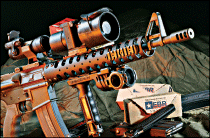 We believe that any CQB carbine for military or law enforcement use should provide for this latest in night vision technology because tactical operations are 24/7, day or night. The AN/PVS-22 mounts ahead of the day optic, eliminating the need for adapters, illuminated reticles and, solving once and for all the eye relief issues associated with earlier night vision devices. It can also be used as a handheld night vision optic. As it was, we had to remove the backup iron sight in order to use the PVS-22.
We believe that any CQB carbine for military or law enforcement use should provide for this latest in night vision technology because tactical operations are 24/7, day or night. The AN/PVS-22 mounts ahead of the day optic, eliminating the need for adapters, illuminated reticles and, solving once and for all the eye relief issues associated with earlier night vision devices. It can also be used as a handheld night vision optic. As it was, we had to remove the backup iron sight in order to use the PVS-22.
Advertisement — Continue Reading Below
Although this is a seemingly minor issue, the fact is that with the War on Terror, many police departments, including the jurisdiction where we reside, are purchasing AN/PVS-22 NVS using grants from the Homeland Security Department. Our department has purchased three of the devices for SWAT use and this is not untypical, according to our sources at the manufacturer. Thus, a longer MIL-STD-1913 top rail is in order to bring the CQB carbine up to the latest technological standard.
Demo Optics
Our test carbine came equipped with an Aimpoint red dot CQB sight mounted via D&L’s proprietary “reality-based” mount. The Aimpoint itself is in widespread military use and is one of the fastest for target engagement. Lauck’s mount incorporates dual crossbolts with hand knobs that can be tightened using a screwdriver for absolute retention and to prevent shooting loose. Another purpose is to hold the Aimpoint in perfect alignment for use with Lauck’s proprietary and innovative backup iron sight that was designed to be as fast as a pistol and as accurate as a carbine.
The sight is placed forward of the optic and stays up so there is nothing to flip up or break. There are three apertures for the sight—a notch, a notch with tritium inserts and a ghost ring for mounting at the rear of the upper receiver. The sight is fully adjustable and then positively locked in place for a backup sight that is always visible and impervious to the rigors of military or law enforcement use. Lauck also replaces the post front sight with a more durable blade that complements the rear sight. The front sight simply replaces the original and, like the rear sight, the front blade is available with a tritium insert.
Advertisement — Continue Reading Below
Stock
The second eye-catching item of D&L Sports’ CQB AR is the patent-pending adjustable stock, again different from any other. The stock is constructed from thick-walled aluminum for durability and light weight. The stock was designed with entry teams in mind because these organizations wear a variety of gear and body armor of varying thicknesses, necessitating an adjustable stock. Conventional adjustable stocks have many issues, including rattling, bending, denting and being subject to breaking under hard use; such as striking the butt on the ground to help open a stuck bolt, or aggressively using the stock in a CQB situation.
Buffer Tube
Not only can the stock be thusly broken, the buffer tube can be bent as well. In addition, standard buffer tubes are retained only by a light lock ring that may loosen under hard use. The lock ring loosening can result in an inoperable weapon. Lauck approached these issues with a view in mind to develop a stock that would be as absolutely reliable and durable as humanly possible. We’d say that he succeeded.
The buffer tube is machined from aluminum bar stock, finished with a thicker diameter than standard tubes. The butt is machined from solid aluminum block to withstand just about any abuse a military or law enforcement user can subject it. The bottom and rear are deeply checkered for traction against vest material. The butt is lightened by material removal that allows for correct sling attachment and is contoured to facilitate a comfortable and secure grip for CQB operations. If necessary, the butt can be removed for cleaning and maintenance.
Advertisement — Continue Reading Below
The sliding butt is retained in place with dual crossbolts that absolutely prevent unintentional stock collapse. Dave Lauck also eliminates the light-duty locking ring by machining a shoulder onto the buffer tube. This is timed during installation to form a solid indexed connection with the lower receiver. Finally, a bottom index bracket ensures that the entire assembly is firmly locked in place via a heavy-duty connection.
Foregrip
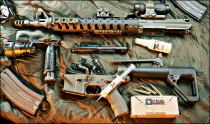 For enhanced handling, Lauck designed his own vertical foregrip. Dave’s foregrip is machined from solid Delrin and retained by two Allen head crossbolts for positive retention. The grip compartment will hold a complete AR bolt assembly and a spare firing pin or two spare batteries, either AA or 123A. The rear pistol grip was replaced by a rubber over-molded ERGO Grip with molded-in finger grooves and textured surface for positive grip. The ERGO Grip has a plug that fits into the base of the grip, forming a second compartment for storing small items.
For enhanced handling, Lauck designed his own vertical foregrip. Dave’s foregrip is machined from solid Delrin and retained by two Allen head crossbolts for positive retention. The grip compartment will hold a complete AR bolt assembly and a spare firing pin or two spare batteries, either AA or 123A. The rear pistol grip was replaced by a rubber over-molded ERGO Grip with molded-in finger grooves and textured surface for positive grip. The ERGO Grip has a plug that fits into the base of the grip, forming a second compartment for storing small items.
Nighttime Performance
For night operations, we replaced the standard vertical foregrip with a SureFire M900 Vertical Foregrip Weaponlight with IR filter. This versatile foregrip/high intensity light has ambidextrous momentary activation pads for the main battle light, a constant “on” switch, and a momentary push switch for the two integral, low-output LEDs that are used for stealth navigation. This light emits 125 lumens of high-intensity focused light for an hour and attaches to the bottom MIL-STD-1913 rail via an ARMS QD throw lever.
Advertisement — Continue Reading Below
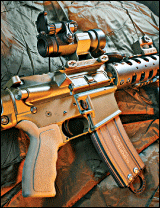 Night vision optics work on amplification of ambient light, and while the PVS-22 is arguably the state of the art in current night vision technology, it is not as effective in total darkness, such as caves or deep inside unlit building interiors. For situations like this, the SureFire IR filter can be clamped over the lamp’s lens, enabling one to clear using IR light that is invisible to the human eye. Of course, IR can be detected by other night vision optics, but the IR SureFire coupled with a PVS-22 is about as good as it gets. The Aimpoint can be used with this combination either with or without the red dot turned on, but we’d probably use it without the dot for night ops, which are typically at CQB distance.
Night vision optics work on amplification of ambient light, and while the PVS-22 is arguably the state of the art in current night vision technology, it is not as effective in total darkness, such as caves or deep inside unlit building interiors. For situations like this, the SureFire IR filter can be clamped over the lamp’s lens, enabling one to clear using IR light that is invisible to the human eye. Of course, IR can be detected by other night vision optics, but the IR SureFire coupled with a PVS-22 is about as good as it gets. The Aimpoint can be used with this combination either with or without the red dot turned on, but we’d probably use it without the dot for night ops, which are typically at CQB distance.
The Aimpoint has IR dot settings for use with less advanced night vision optics that must be mounted behind the optic, but can be used at CQB distances with the dot turned off. In the case of our test D&L CQB carbine, night ops with a PVS-22 also required removal of the backup iron sight in the carbine’s standard configuration, so at the risk of being redundant, we recommend that D&L adapt the CQB to present night ops via an extended or full-length top rail to facilitate 24/7 use with the backup sight in place.
Upper & Lower Receiver
D&L CQB carbine upper and lower receivers are fitted with no discernable “play.” The lower receiver is forged 7075-T6 aluminum, while the upper is 6066-T6. The trigger is a single-stage unit with absolutely no creep or backlash and breaks like snapping a glass rod at just under 4 pounds, although the trigger feels as if it were lighter. We were actually surprised when we measured the average pull weight. Lauck’s selector switch is yet another enhancement. The switch has been lengthened and widened slightly to facilitate high-speed operation, even with gloved hands. The switch is available in both right- and left-handed versions. Another improvement is Lauck’s anti-walk trigger and hammer pins, which like much else on this carbine, differ from any others.
Advertisement — Continue Reading Below
Barrel
D&L’s barrel is a Krieger, heavy contour stainless, 16 inches in length with Lauck’s proprietary integral muzzle brake. This brake is a nine-port design with six side ports and three ports on top. There are no bottom ports because this reduces dust signature when shooting from prone or from a foxhole, while at the same time minimizing muzzle rise, thereby enhancing rapid-fire accuracy. Although felt recoil from any 5.56mm carbine is low, Lauck’s design effectively reduces felt recoil to practically nil. Another barrel note is that Lauck chambers his barrels to 5.56mm NATO dimensions. Space prevents details, but the bottom line is that .223 ammunition can be fired from rifles chambered to 5.56mm dimensions, but not the opposite because .223 chamber dimensions are slightly less than those of 5.56mm, resulting in potentially dangerous chamber pressures if a 5.56mm cartridge is fired from a .223 dimensioned chamber
Magazines
Dave Lauck even designs his own 20- and 30-round magazines. Original magazines have always been problematic in terms of reliability, especially given that they were originally designed to be used only once and then discarded. Needless to say, the military considered this to be wasteful and so magazines were retained and reused, causing feeding issues. During the Vietnam unpleasantness and afterwards, we loaded only 18 rounds into 20-round magazines, and 28 rounds into the 30-rounders to enhance reliability and feeding. The green followers with a longer front bearing surface to prevent “nosedives” and enhance feeding was only partially successful and prudent shooters continue to load 28 rounds into MILSPEC 30-round magazines.
Lauck solved the AR magazine problem in several ways. First, he designed a completely new aluminum follower that absolutely will not nosedive or allow “bolt over cartridge base” failures to feed. The follower also has what Lauck designates “filter tracks,” which allow dirt and dust to pass by the follower. In addition, Lauck redesigned the magazine base by locking it firmly into position using screws to retain the heavy-duty aluminum floorplate that doubles as a “pull ring” for withdrawing the magazine from a pouch and retaining it while reloading. It also can be used to pull the magazine from the carbine if it fails to fall free when the release is pressed. Lauck completely redesigned the 20-round magazine by incorporating a slight curve into the design in addition to the features we have already discussed. There have been earlier curved 20-round magazines, but none has all the features of Lauck’s.
Advertisement — Continue Reading Below
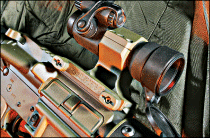 Shooting Impressions
Shooting Impressions
Shooting the Precision AR brought no surprises. We tested the carbine with Black Hills 77-grain match, Engel Ballistic Research 55-grain frangible and Wolf 62-grain FMJ. There are those that disparage Wolf ammo, but we have found it to be clean, reliable and reasonably accurate. It isn’t match grade ammo, but for training and informal shooting, it is excellent. Engel Ballistic Research is a relative newcomer, but their 55-grain frangible ammo delivered the best group of the day, beating out Black Hills’ 77-grain Sierra Match King.
D&L Sports CQB AR is probably the most accurate rifle of its type we have ever tested. It is also probably the best constructed in the finest tradition of individual custom rifles. For the tactical team seeking a semiautomatic AR-type rifle with excellent accuracy, the D&L Sports CQB AR is an obvious choice. Whether or not the price of admission is worth it is a matter the individual will have to decide for himself, but the D&L Sports CQB AR is about as good as it gets in terms of overall accuracy for either sporting or tactical purposes at any price. For more information, visit dlsports.com.
